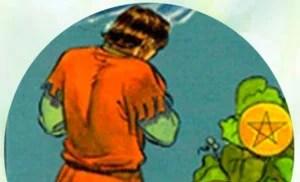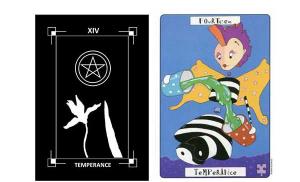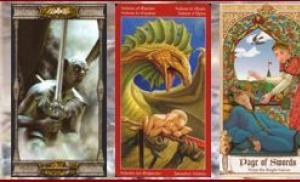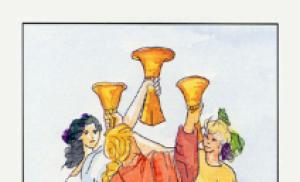Depiction of human figures in the history of art. Summary of an art lesson on the topic “Depiction of the human figure in the history of art” (grade 7)
Berdnikova L.G. MHC teacher
MHC lesson plan for 7th grade.
Topic: “Depiction of the human figure in the history of art”
Goals:
1.Introduce students to ideas about human beauty in the history of art.
2. To cultivate a moral and aesthetic attitude towards the world and a love of art.
3. Develop creative and cognitive activity.
Equipment and materials: selection of illustrations and reproductions of works of art of various genres and periods with images of the human figure, presentation, video “The Beauty of a Woman through the Ages”
During the classes
"Man is the measure of all things"
Protagoras
Man has always been and remains the main theme in art. The idea of the beauty of a person, of the most essential in his appearance and his actions, has changed in the history of art. Works of plastic arts as unique documents of history in bright and visible images convey to us the ideas of human beauty that existed in various historical eras.
What were the ideas about the beauty of a person and his body? Do you love to travel? In today's lesson, let's take a tour through the pages of history, through the pages of civilizations and see how human beauty was assessed in different periods of history.
Look carefully at the title of our topic. What do you think will be discussed? What is the most logical place to start characterizing the ways of depicting a person in the history of art?
So, we came to the conclusion that the excursion should begin from the first days of life of ancient people.
Imagine that we find ourselves in a museum of fine arts and are looking at the exhibition “Man is the measure of all things.”
I will be your guide, and you will be attentive listeners. Very often, visitors do not rely on their memory and write down what they hear in notepads. Let's try to take this useful experience into account; instead of notebooks, you will have notebooks in your hands, where you will enter the material you heard during the excursion. At the end of the lesson, perhaps I will have questions for you about what I heard and I will look at your notes. Ready? Let's hit the road!
Take a close look at the “Paleolithic Venus” stand. It depicts small figurines of women found by archaeologists during excavations. Describe them.
Checking task completion
So, we saw that these small sculptures demonstrate both skill and primitiveness.
In a textbook on the history of world artistic culture, we can read about it this way: “The mastery is in how integrally and strongly the plasticity of body volumes is felt: in this sense, the figures are expressive and, despite their small sizes, even monumental. But there is no glimpse of spirituality in them. There is not even a face - the face was not of interest, probably it was simply not recognized as an object worthy of depiction. “The Paleolithic Venus, with her swollen belly and huge bags of breasts, is a vessel of fertility and nothing more.”
(Dmitrieva, N. A., Vinogradova, II. A. Art of the Ancient World.—M. 1989.—P. 15.)
Question: - Why did the ancient artist depict the female figure in this way?
Students express their opinions.
Indeed, the figures of these women can hardly be called the standard of beauty of today, but in those distant times, people created these figures not with the goal of conveying female beauty, but to embody in the material the power of the feminine principle, the ability to bear children and feed. That is why many of the figurines found depict women with large breasts, hips and a pregnant belly. Obviously, for the people of that time, a woman was something akin to a deity who carries eternal life and prosperity.
How did ideas about human beauty change further and what rules for depicting a person began to appear? We enter the hall “Ancient Egyptian reliefs and images of man”
Question: - Do you think the ancient Egyptian artist strives to depict a specific image or a generalized one? — What in the depiction of the human figure seems unnatural to you?
Students express their opinions.
(Shoulders are turned to the front, and the head and legs are in profile.)
However, this position of the figure does not detract from the expressiveness, it makes it possible to examine it from different points of view and contributes to a holistic perception of the individualized image, obtaining the most complete information about what is depicted.
There was a certain Canon - a set of rules and laws that the artist had to follow when constructing a drawing - which regulated a unique criterion of beauty in ancient Egypt.
Question: — According to the canon, who do you think the ancient Egyptian artist should have depicted most diligently and strictly according to the rules?
Students express their opinions.
The ideal of beauty, the height of perfection in ancient Egypt was the pharaoh. He was depicted strictly according to the canons in order to show all the greatness and God's chosenness of the pharaoh - after all, the ruler was considered the son of the gods and was equal to them. However, in reality, pharaohs were often far from ideal: in 1922, when Howard Carter found the tomb of the young Egyptian pharaoh Tutankhamun in the Valley of the Kings, untouched by tomb robbers, it was discovered that the young pharaoh had one leg shorter than the other. This, apparently, was well hidden, since in Ancient Egypt such a deficiency was considered a punishment from the gods, and if a ruler was found to have a physical disability, the people might have doubts about his right to the throne.
We continue our excursion. Before you are works of art from another era.
Question: - Where and when were they created?
Students express their opinions.
Scientists distinguish three periods in the history of Greek art:
1) archaic, or ancient period - from approximately 600 to 480 BC
2) classic, or heyday, from 480 to 323 BC. - year of death of Alexander the Great
3) Hellenism, or late period; it ended in 30 BC
The ancient art of Greece and Rome shows the beauty of a physically perfect person.
Question: - Remember the lessons of history and answer: “What principles guided artists when depicting a person?”
Students answer.
In the art of Ancient Greece, an image of an ideally beautiful and harmoniously developed human citizen, a valiant warrior and patriot was formed, in whom the beauty of an athletically trained body was combined with moral purity and spiritual wealth.
This was reflected in sculpture, painting and decorative arts. Greek masters studied the structure of the human body, the proportionality of its proportions, the plasticity of movements, especially during the Olympic Games.
Before you is the famous sculpture of the ancient Greek sculptor Myron “Discobolus”.
Please note: the sculptor attaches great importance to the proportional relationships of the parts of the athlete’s figure; everything in it is proportionate and harmonious.
Myron develops the motive of movement... The human body takes the following pose: the discus thrower holds a disc in his hand, the other arm is bent at the knee. His whole body at this moment is likened to a bent bow.
Let's move on. Our next exhibition is dedicated to the sculptor Praxiteles, who gave the world a statue of Aphrodite of Knidos, the goddess of love and beauty. In Ancient Greece, the beauty of the human body was a guarantee of the beauty of the soul.
Phryne was a model and friend of Praxiteles. It was she who served as the model for the statue of Aphrodite of Knidos. For this she was accused of sacrilege and blasphemy. Because those who knew Phryne smiled when looking at the statue of Aphrodite, and those who saw the statue looked at Phryne with reverence. The pilgrims, bowing before Aphrodite, whispered “how beautiful is your divine beauty, O Phryne,” and exclaimed out loud, “Aphrodite, beautiful Aphrodite.” For this, Hethera Phryne was accused of blasphemy. When her defense attorney at the trial, Hyperides, did not have enough words to answer the accusations and he exposed Phryne’s chest, exclaiming “Look! Can a girl with such a beautiful body blaspheme and lie to us? Her soul is as beautiful as her perfect body!” According to legend, the judges, blinded by her beauty, stopped the trial.
Let's proceed to the hall called “The Art of Ancient Rome”.
Ancient Rome became the heir to the artistic culture of Hellenism. The sculptural portrait of this time was distinguished by its accurate characterization and life-like verisimilitude of the images.
In front of us is a Roman statue - the Statue of Octavian Augustus addressing the troops.
The image of Cupid, the son of the goddess Venus (Aphrodite), recalled the divine origin of the emperor - her descendant. It is an idealized monument to a powerful ruler. The frail and sickly first Roman emperor Octavian is portrayed as athletically built, a “god-like man.”
Question. - Look at the statue next to Octavian Augustus. What do you see in this person's eyes?
Students express their opinions.
If we call Ancient Greece a world of aesthetes, Ancient Rome is a world of warriors, a world of conquerors. There is no place for the beauty of the body, we see something else. In the eyes of the warrior-conqueror, we will see both the memory of the battles through which the Roman went through, and the pain of losing comrades and loved ones. We will see fortitude and self-confidence.
We move to the "Renaissance" hall
The spiritual and physical beauty of man is the main theme of the work of the great Italian artist and sculptor of the Renaissance Michelangelo. To the question “How do you manage to create such magnificent statues?” he responded with the phrase “I take a block of marble and cut off everything unnecessary from it.” His “David” is a majestic and beautiful young man, filled with boundless courage, determination, and nobility. He is calm, but one can feel his readiness to make every effort to fight evil and for the victory of justice. This is a true monument to a heroic personality, a person who was spiritually and physically perfect.
Michelangelo sculpts his sculpture from marble. The large block of stone had defects, there were cracks in it, and no one believed that anything could be made from this bulk. But the artist got to work, carefully thought out the future plastic image, and was able to “extract” a great unfading image from the marble monolith.
Question: — “David” is a famous biblical hero, by what feat did he glorify himself? Why do you think Michelangelo turned to ancient images to realize his plan?
Students discuss and answer questions.
Let's turn to a book about the art of this period. In it we can read the following: “According to the biblical legend, young David (then just a shepherd, later a wise ruler) killed the giant Goliath, defeating him with a stone thrown from a sling. Michelangelo created the statue for his native Florence, for David defended his people and ruled them fairly: so the great sculptor, with his art, wanted to establish the ideal of citizenship in which he saw the salvation of his humiliated homeland.”
Question: Which sculpture did you like best? Why?
Each era finds artistic forms of reflection of its ideas about beauty that are adequate to historical time.
The era of the Italian Renaissance, along with sculptural images, gave the world many paintings. Here are two works by outstanding masters of that time: Giorgione and Leonardo da Vinci.
Painted by Dcorgione in the early years of the 12th century, “Judith” affirms the ideal of the High Renaissance, which found expression in the painting through the internal emancipation of the composition, the regularity of pictorial forms, the beauty and sophistication of the female image, and the melodiousness of the line of colorful combinations.
“She is beautiful and unusual - Judith Giorgione,” writes art critic A. Varshavsky. - The beautiful Judith volunteered to liberate her hometown from the terrible danger hanging over it. With the leader of the enemy troops, Holofernes, she returns to her father's house.
The enemies trembled, they will flee when the head of Holofernes is displayed on the city wall, and the feat of the young widow, her self-sacrifice, her successful daring fellow citizens, those whom she saved from a foreign yoke, perhaps from death, will forever be glorified.
It's all over now. Everything has already happened. And Judith looks thoughtfully at the severed head of the enemy commander. What flashes before her mind's eye?
Perhaps one of the greatest strengths of Giorgione’s genius was his ability to calmly express his unease.
They say that the legend of Judith was especially loved in
Venice. Her image has become a kind of symbol of love for the fatherland and self-sacrifice.”
The Mona Lisa is considered Leonardo's most famous painting. We can see it in Paris, in the Louvre. Rows of long galleries, on the walls - precious evidence of the creative genius of man; every sketch, every painting is a treasure trove of the historical past, living evidence of a select few.
The painting is only 30 inches tall and shows the Mona Lisa seated on a low folding chair; her body is turned to the left, her right hand resting on her left forearm. The face is facing the viewer at a slight angle, while the brown eyes look straight at you.
In the background is a fantastic landscape with hills and mountains, warm and soft tones, with a gradually brightening sky above it. The two columns at the edges of the landscape are covered by the current picture frame. All the details in this painting are beautiful, but what grabs your attention first of all is the face.
The picture cannot be described in words: the longer you look at it, the more its impact on you increases, and you begin to feel that amazing charm that has captivated so many people over the centuries. Moreover, Leonardo achieved an interesting effect: no matter from which corner of the room you look at the Mona Lisa, she will seem to be pursuing you with her gaze.
Man has always been and remains the main theme in art. Ideas about the beauty of a person, about his relationship to God, about the most essential in his appearance and his actions have changed in the history of art.
Let's see how!
APPEALS TO THE VIDEO.
(showing images of women throughout the development of painting)
You've probably already seen some works, and some will only be revealed to you now..
Our excursion is coming to an end. Let me look through your notes.
(The teacher looks through the notebooks of several students)
Now try to answer my questions
— What unites all these works?
- What is your idea of human beauty?
— How do you understand the meaning of the expression “spiritual beauty”?
—Which of these works made the greatest impression on you?
The students answer.
Summing up the lesson.
Yes, Man is the main theme in art. Each historical era expresses the understanding of beauty in its own way, but in this diversity, of course, there is something in common.
- Image of a human figure
- in art history
- Within this art form, images of humans are especially rare. Occasionally you can see human images - less realistic than animal images - in carvings or in the form of figurines and extremely rarely in drawings. Both male and female figures are depicted naked. On the latter, in some cases, decorations are visible. If on male figures facial features (eyes, mouth) are clearly drawn, then on female figures this is much less common: only on the head of the Venus of Brassempouille (Grotto de Pape, France) the nose and eyebrows are drawn.
- Female images of this era represent a certain group of so-called “Venuses”, although their anatomy is far from the standards of harmony. Their carved or sculptured images are distinguished by the large size of their chests and buttocks, in comparison with which the head, arms and legs look small and thin.
- “Venus of Willendorf” (Vienna, Natural History Museum). "Venuses of the Paleolithic era were called “fat women” (“bellied”) for the morphological characteristics of their buttocks. Emphasized obesity, primarily in the abdomen and chest, that is, in organs associated with motherhood, does not correspond to apparent realism, but reflects the idea of fertility and symbolizes the reproductive function of a woman
- “Venus of Lossel”, also called the Lady with a Horn,” a bas-relief on a limestone rock (size - 42 cm), stored in the Museum of Aquitaine (Bordeaux, France).
- She is depicted in the frontal plane and in a manner typical of “Venus”: with a volumetric highlight of the hip part of the body. The woman holds a horn in her hand raised up and to the side. Her head is turned towards the horn, and her hair falls in the opposite direction. The other hand lies on the stomach and is directed towards the pubis. The presence of the horn confirms the idea that this "Venus" represents a symbol of fertility. Horns, fragmentary images of which indicate the presence of an animal - as a guarantee of an abundance of food - have a specific meaning here. The body of the body is clearly drawn with a clear image of large saggy fatties, a convex belly and maximally reduced legs, similar to some vague additions.
- Despite the frontal position of the body, the profile head, devoid of facial features - a sign indicating the absence of individual characteristics - imparts to the figure a certain semblance of movement.
- The shapes of the head are best seen in profile, which is how they are shown. But we always mentally see the eye from the front. Accordingly, the facial profile is complemented by a full-face image of the eye. The upper body, shoulders and chest, are most fully perceived from the frontal position, since the articulations of the arms and the body are visible this way. But the hands and feet are clearly outlined only when viewed from the side. All this explains why the figures of people in Egyptian art look so strangely flat and as if curved. In addition, Egyptian artists found it difficult to represent both feet as they were seen from one position. They preferred a clear outline that outlined the big toe and instep of the foot. So both feet were depicted on one, inner side, as if a person, as in this relief, had two left legs. This does not mean that the Egyptians thought that human beings had such an appearance. They simply followed a method that allowed them to capture everything that seemed significant in the human figure. Apparently, the severity of formal regulations is somehow connected with the magical functions of images. Otherwise, how could a person with a “shortened” or “cut off” hand accept and bring gifts to the dead?
- In the sculpture, all seated figures have their hands on their knees; male bodies were painted a darker color than female ones.
- The artists of ancient Egypt depicted people according to the canons.
- CANON - a set of rules and laws that should
- be guided by the artist when constructing a drawing, -
- regulated a unique criterion of beauty in Ancient Egypt
- The ancient art of Greece and Rome shows the beauty of a physically perfect person. The image of a young athlete embodies the features of a beautiful and harmoniously developed person, in whom the beauty of a physically trained body is combined with moral purity and spiritual nobility. With an energetic, powerful movement of his left shoulder forward, he prepared to throw the discus. At the same time, he experiences enormous physical stress, but outwardly remains calm and restrained. It seems that the sculptor is interested not so much in the physical effort of the athlete, but in his strong-willed concentration and fortitude.
- The statue of Octavian Augustus was made by a Roman sculptor in 27 BC.
- The frail and sickly first Roman emperor Octavian is portrayed as athletically built, a “god-like man.” The sculptor managed to capture the unique type of face and characteristic hairstyle of the emperor, emphasizing his determination and purposefulness
- Michelangelo's "David" is a majestic and beautiful young man, filled with boundless courage, determination, and nobility. He is calm, but one can feel his readiness to make every effort to fight evil, for the victory of justice. This is a true monument to a heroic personality, a person who was spiritually and physically perfect. Michelangelo sculpts his sculpture from marble. The large block of stone had defects, there were cracks in it, and no one believed that anything could be made from the bulk. But the artist got to work, carefully thought out the future plastic image, and was able to “extract” a great unfading image from the marble monolith
- A global catastrophe is happening before our eyes. People are captured by the angelic message about the approach of the Last Judgment in the midst of their everyday activities. But Providence is inexorable: on the right, sinners are thrown into hell like an avalanche, they are urged on by angels, and dragged along by demons. On the left, the righteous ascend to heaven. The muscular Jesus is merciless and unyielding in his anger, which is more reminiscent of the ancient thunder god embodying retribution. Only the Mother of God sadly bowed down, sympathizing with the suffering of people, but not having the right to help them.
- Saint Bartholomew sits on a stone by the spring. His eyes glow with a fiery threat. In his hand the saint holds his own skin, which was once torn off from him by opponents of Christianity. On this skin, Michelangelo depicted his face, distorted by incredible suffering. The artist emphasizes that he himself - here and now - suffers no less than the sinners at the Last Judgment. Michelangelo's beauty is imbued with suffering and compassion.
- Painted in the first years of the 16th century, “Judith” affirms the ideal of the High Renaissance, which found expression in the painting through the internal emancipation of the composition, the regularity of pictorial forms, the beauty and sophistication of the female image, the melodiousness of linear and colorful combinations.
- “She is beautiful and unusual - Judith Giorgione,” writes art critic A. Varshavsky. _ The beautiful Judith volunteered to free her hometown from the terrible danger hanging over it. With the head of the leader of the enemy troops, Holofernes, she returns to her father's house. The enemies trembled when the head of Holofernes was displayed on the city wall, and the feat of the young beautiful widow, her self-sacrifice, her successful daring fellow citizens, those whom she saved from a foreign yoke, perhaps from death, will forever be glorified.
- ... It's all over now. Everything has already happened. And Judith looks thoughtfully at the severed head of the enemy commander.”
- This spiritualized image has everything: tenderness and dignity, meekness and regret, inner strength and charm.
- The parted curtain reveals to us the simple and at the same time majestic figure of a woman carrying a baby in her arms. The mother's gaze is directed at the viewer and at the same time into the distance, foreseeing her future sufferings and the feat of the Son of God. The Queen of Heaven is filled with the consciousness of a great and sorrowful destiny - she bears her Son to people as an atoning sacrifice. Jesus in her arms is not just a foolish child, he is a serious boy, in whose gaze one can also read a foreboding of his own fate. Madonna walks on the clouds, but her bare feet even on this soft heavenly cover look touching and defenseless. Ideality and humanity, balance of composition and a sense of movement, simplicity and sublimity - all this interacts, enriching each other
- Large figures of a mother and baby are given in the conventional space of a cell, enlivened only by a cold spot of greenish sky in the window. The faces of the mother - still very young Mary - and little Jesus are illuminated with a golden glow. The Madonna's face is affectionate, playful - she hands the Son a flower and admires how He studies it with a serious expression on his face that is not childish. White flowers on a dark green stem serve as a connecting element between mother and baby. Taking a closer look, we see in the four-petal flowers the motif of the cross - the future crucifixion.
- The balance of the composition - two large figures between two windows - creates a feeling of long-term, joyful peace. The Madonna’s clean forehead is sculpted with cold, clear light, her soft, slightly sad half-smile and her eyes are directed down at the Son. The curly reddish-golden hair of Jesus is painted with amazing realism, liveliness, and warmth. The gaze of the divine child is fixed on the viewer with childish sadness and insight.
- Yes, man is the main theme in art.
- In every historical era there was
- understanding beauty in your own way,
- but in this diversity there is something in common….
7th grade
Personal UUD : Have an idea about the historical nature of the artistic process, about the features of the image of a person in the history of art. Perception of works of fine art,mastering new types of creative activity; making a drawing according to your own ideas.Regulatory UUD : come up with and implement an original idea for the upcoming work.
Organization of space
Forms of work
Resources
Frontal
Work in pairs
Individual
Printed products :A. S. Piterskikh, G.E. Gurov, “Fine arts. Design and architecture in human life. 7th grade"edited by B.M. Nemensky. M.: - Education, 2014.
Visual range : presentation on the topic of the lesson.
Technological lesson map
Technology study
The teacher organizes the students’ activities by proposing a topic and a series of questions:What is the purpose of our lesson?
What will we learn to do?
What do we need for this?
They listen, formulate the goals of the lesson, and plan subsequent activities.
Discovery of new knowledge
Have an idea about the historical nature of the artistic process, about the features of the image of a person in the history of art. Be able to perceive works of fine art.
Comparison of ways to depict a person in the history of art
Students, under the guidance of a teacher, analyze the visual sequence and the task to determine the level of difficulty.
Application of new knowledge
Analysis of the received visual information, impressions, highlighting the stages of work on the drawing
Demonstrates the proportional relationships of a person according to the canons of Ancient Egypt.
Directs students' perception of information.
Draw in pencil. Then, independently, according to certain stages of work, they complete the drawing in color
Relaxation
Carrying out a dynamic pause
Reflection on learning activities
Analysis and self-analysis of activities.
Express exhibition of the best works.
The teacher creates conditions for a favorable analysis of students’ own activities in the lesson to sum up.
Grades are given.
Students answer the teacher’s questions, evaluate the work of classmates and their own activities.
Annex 1.
Man is the measure of all things. (Protagoras)
Man has always been and remains the main theme in art. Ideas about human beauty have changed throughout the history of art.
Works of painting, sculpture and graphics, as unique documents of history in vivid images, convey to us ideas about human beauty in various historical eras.
Today in the lesson we will take a tour through the pages of history, through the pages of civilizations and see what ideas about human beauty were.
Look carefully at the title of our topic. What do you think is the most logical place to start characterizing the ways in which people are depicted in art history?
So, we came to the conclusion that the excursion should begin from the first days of life of ancient people.
Imagine that we are in a museum of fine arts. I will be your guide, and you will be attentive listeners. At the end of the lesson I will have questions about what I heard, so listen very carefully.
We enter the hall “Ancient Egyptian reliefs and images of humans.”
Do you think the ancient Egyptian artist sought to depict a specific image or a generalized one? What about the depiction of the figure seems unnatural to you?
However, this position of the figure does not detract from its expressiveness and makes it possible to examine it from different points of view.
There was a certain canon - a set of rules and laws that the artist had to use when constructing a drawing.
Who do you think the ancient Egyptian artist had to depict most carefully and strictly according to the rules?
The ideal of beauty, the height of perfection in Dr. Egypt had a pharaoh. He was depicted strictly according to the canons in order to show all the greatness and chosenness of the pharaoh - after all, the ruler was considered the son of the gods and was equal to them. Although in reality the pharaohs were far from ideal.
The next room is “The Art of Ancient Greece”.
In art Dr. Greece developed the image of an ideal person, a valiant warrior, in whom the beauty of an athletic body is combined with spiritual wealth.
Greek masters studied the structure of the human body, the proportionality of its proportions, and plasticity in movement, especially during the Olympic Games. Vases were decorated with images of people, and interiors were decorated with sculptures.
Let's proceed to the hall called “The Art of Ancient Rome”. During this period, the sculptural portrait was most developed. If Dr. Greece is a world of aesthetes, then Dr. Rome is a world of warriors, a world of conquerors. In sculptural portraits of this time, the main thing is the depiction of the character and spirit of a person.
The Renaissance, along with sculptural images, gave the world many paintings. Here are two works by outstanding masters of that time: Giorgione and Leonardo da Vinci. Judith and Mona Lisa.
Man has always been and remains the main theme in art. And ideas about his beauty, about his relationship to God, about his character and standard have changed in the history of art.
The purpose of the lesson:
1. Introduce students to the process of an artist’s work on an image of a person
2. Develop skills in mastering drawing techniques
3. Cultivate motivation for learning activities
4. Learn to draw with a pencil
Download:
Preview:
TOPIC: “DIMAGE OF THE HUMAN FIGURE AND THE IMAGE OF HUMAN IN THE HISTORY OF ART”
Goals:
- introduce students to the process of an artist’s work on an image of a person;
- develop skills in mastering drawing techniques;
- cultivate motivation for learning activities;
- learn how to draw with a pencil.
- teach how to depict human proportions from life and from imagination
Equipment: visual aid: 1) “Great artists. Leonardo Da Vinci" 2) "Great artists. Michelangelo" 3) diagram 1, diagram 2
Lesson plan.
- A conversation about drawing, about the canons of depicting a person.
- Setting an artistic task.
- Sample of pedagogical drawing.
- Practical implementation.
- Summarizing.
During the classes.
I. Organizational moment.
Checking readiness for the lesson.
II. Lesson topic message. General information about the drawing.
Drawing - the most important means of studying and displaying reality, the fundamental basis of all realistic fine art. Mastery of drawing is necessary for artists of all specialties: graphic artists, painters, sculptors, architects, designers. It is necessary for an engineer, a geographer, and a doctor. Today in the lesson you will begin to understand the technique of drawing; we will get acquainted with the rules of constructing the face and the human body.
III. Learning new material.
Man's depiction of himself in the form of schematic cave paintings and sculptures carved from stone and bone appeared much earlier than a conscious idea of artistic creativity was formed. Man's awareness of himself as an individual and turning to artistic creativity was the greatest event, unparalleled in the history of mankind in terms of the possibilities that were inherent in it. Long before the advent of writing, our ancestors found the opportunity to tell us a lot about their way of life, about the climate and fauna, about their harmonious connection with nature.
In all eras, man has been and remains the main theme in fine art. But undoubtedly ancient art became a hymn to man, his spiritual and physical beauty. In the images of the Olympian gods and mythological heroes, the Hellenes glorified the perfect man, in whom the physical beauty of an athletic body is combined with spiritual nobility and moral purity. No one was able to achieve such perfection in depicting the human figure as the Greeks. The images of their goddesses, endowed with unearthly beauty, slender and muscular gods, with all their ideality, are vital and natural.
The desire to depict the human figure with ideal proportions continued in the art of the Renaissance. Throughout his work, Michelangelo affirmed the idea of the greatness of man and the beauty of the human figure and masterfully conveyed this in the statues of David and Moses. All outstanding masters knew perfectly well the structure of the human body, and it should be noted that of all that the artist draws, the most complex is the human figure. Most works of art depict a person. Moreover, it is often the main compositional element of the picture, so an artist cannot be a master of his craft if he does not learn to draw people from life and without life. The principle of drawing a human figure is no different from working on another model, i.e. First you need to determine the highest and lowest points of the figure so that the model fits on a sheet of paper. Next, you need to correctly position the figure, determining its position in relation to the horizontal plane on which the model stands, and its position in space in relation to the vertical. To do this, you need to determine the position of the central center line, which runs along the spine and determines the position of the torso. Very often in the drawings of novice artists, a standing figure gives the impression of falling. This happens because the perpendicular, lowered from the center of gravity of the body, is located outside the steps of its legs. If the figure stands without leaning on anything, then this perpendicular should pass within the feet or between them. Only under this condition will the standing figure give the impression of stability.
Beginning artists also often make mistakes in basic proportions: the head is too large or small in relation to the body, the legs are short, the arms or neck are long, like a “giraffe,” the body is like an “elephant,” etc. To facilitate the work in constructing the human figure, artists determined the basic proportions (canon), taking as a unit of measurement some part of the body, for example, the head. In a tall person, usually the lower part of the body (from the pubis to the heel) is equal to the upper part (from the crown to the pubis); in people of medium and short stature, the upper part of the figure is slightly larger than the lower part, since people’s height changes mainly due to the length of their legs; The size of the head in tall people is 8 times the length of the body, in people of average height - 7.5 times, and in people of short stature - 7 times; in a standing person, the lowered arms with outstretched fingers reach half the thigh; if a standing person spreads his arms to the sides, then the distance between the fingertips of the right and left hands will be equal to his height. The proportions indicated are not an exact formula that the painter should use, regardless of the model. Each person, like every creation of nature, is individual, unique and inimitable; this can only be understood and seen by being observant.
IV. Practical work.
Exercise.
Using the proposed drawing schemes, you need to complete a series of sketches from life. In your work, you can use pencils of different hardnesses.
During practical work, the teacher makes targeted rounds:
1) Control of workplace organization;
2) Monitoring the correct execution of drawing techniques;
3) Providing assistance to students experiencing difficulties;
V. Lesson summary.
1. Exhibition of student works.
Scheme1 Scheme2
The image of a person in the ancient culture of Egypt. The image of man in the art of Ancient Greece: the beauty and perfection of the design of the ideal human body.
Artists and sculptors convey their attitude to the world through certain images. By depicting a person, the master shows us his ideas about beauty. However, these ideas have changed over time, and ancient monuments of art confirm this.
Over time, people change, which means the art of depicting a person also changes. Let's see how a person was depicted in the era of Ancient Greece.
Sculpture of the 6th - early 5th century. BC e.
If we look at the illustrations depicting sculpture from the era of Ancient Greece, we will notice that then the masters most often depicted young athletes with their arms pressed to their bodies and their legs extended forward. The chosen position was not random. Greek sculptors, creating their works of art, borrowed a lot from Ancient Egypt. So. this image was fully consistent with the Egyptian sculptural canons, which had a huge influence on the development of Greek art. A canon is a set of rules that prevail in the art of a particular period or movement, as well as a specific work that serves as a model. It is believed that the canon is “the law and measure of beauty.”
In the VI-V centuries. BC e. Greek masters also turned to another type of sculpture, which was called “bark”, i.e. “girl”. Goddesses depicted in the archaic era resemble mortal beauties, their figures are imbued with femininity and lyricism.
Sculpture of the first half of the 5th century. BC
At this time, masters usually depicted athletes - winners of the Olympic Games. It was this theme that remained leading in the art of plastic arts throughout the century. A small bronze figurine of a young man preparing to jump is an example of sculpture dating back to the 5th century. BC e. Great sculptors were entrusted with glorifying the heroic image of a valiant and strong citizen as a reliable defender of the ancient Greek city - the polis.
Sculpture of Myron
One of the best masters of Ancient Greece is Myron. The Athenian sculptor was distinguished by an amazing gift for conveying human beauty. His most famous work, “Disco Thrower,” is striking in its grandeur
Please note. how the master depicted the appearance of a person. The image of the discus thrower looks natural and real. Myron is the first sculptor of antiquity to depict a person in motion.
Other works by Myron include the sculptural group “Athena and Marsyas”
Sculpture of Polykleitos
The second largest sculptor of the 5th century. BC e. there was an outstanding sculptor Polykleitos. The main theme of his work was also the person, the winning athlete. It was Polykleitos, in the classical period, who embodied the image of a beautiful and valiant citizen of the polis, which worried the sculptors of antiquity. In his statues, Polykleitos tried to convey the perfect proportions of the human body, based on mathematical calculations. The ancients attributed to the sculptor a famous work called the Canon. Polycleitus built a strictly thought-out system
the relationships of all parts of the statue. One of the most famous statues of that time is rightfully considered his “Doriphoros” - a young man carrying a spear.
Take a look at this statue: how subtly the plasticity of a healthy, muscular body is conveyed. The person is depicted in readiness for action, glowing with vitality. The young man stands as if the entire weight of his body is directed at one leg, and the other is slightly bent, as if in a measured step. The head bowed and turned towards the right shoulder creates the impression of relaxed thoughtfulness. The beauty of the human body is revealed in the proportion of elastic legs and powerful volumes of the chest and shoulders. In ancient times, “Doriphoros” itself was sometimes called the “Canon of Polykleitos”, believing that the master created the statue so that other artists could use it To ak model.
Sculpture of Phidias
Cicero about Phidias: “When he created Athena and Zeus, he had no earthly original in front of him that he could use. But in his soul lived that prototype of beauty, which he embodied in matter. It is not without reason that they say about Phidias that he worked in a fit of inspiration, which lifts the spirit above all earthly things, in which the divine spirit is directly visible - this heavenly guest, as Plato puts it,”
An outstanding representative of ancient Greek sculpture of the 5th century. BC e. is Phidias, the great master of the mature classics. Under his leadership, the design of the Parthenon, the central building of the Athenian Acropolis, was completed. Inside the temple was the famous sculpture of Athena the Virgin, created by Phidias from gold and ivory. The second sculpture of Athena was located in front of the sanctuary and was made of bronze. These works are striking in their naturalness.
Sculpture of Praxiteles
This sculptor performed his work in marble, and it was thanks to this that he skillfully created a soft play of chiaroscuro in his images. Take a look at his statue "Aphrodite of Cnidus" (Fig. 3). This work enjoyed great fame. The statue is distinguished by nobility, grace, passionate and at the same time virgin grace. It was in it that Praxiteles was the first to depict all the beauty of the female body.
Creativity JIucunna
The creations of this master are also interesting. Lysippos strove to create the image of an ideal person. His statue of “Apoxiomenos” is remarkable - an athlete cleaning his body with a scraper. The sculpture has a rather complex structure; it reflects all the laws of proportion.
The group of sculptures depicting the labors of Hercules amazes with its beauty. The most famous of them is “Hercules fighting the lion.” The beauty of the human body is conveyed in muscle tension. The opponents are depicted in dynamics, the pose of the panting lion is unstable, and the man, on the contrary, stands firmly and confidently, openly demonstrating the beauty and strength of his ideal body.
Thus, ancient art was aimed at showing the viewer the beauty of a physically perfect person.













